Liverpool Corporation Tramways, No. 762

Liverpool 762 outside the Wirral Transport Museum on 18th April 2015. Photograph: Jim Dignan

Liverpool 762 outside the Wirral Transport Museum on 18th April 2015. Photograph: Jim Dignan
When Liverpool Corporation Tramways decided to modernise its ageing fleet of four-wheel tramcars towards the end of the 1920s, it began by designing a new set of smooth-riding bogie trucks in 1929 for an experimental single-decker tramcar (“subway” car no. 757). Although the projected subway between Liverpool and Everton for which it was designed never came to fruition, these same trucks – built by the Preston-based English Electric Company – were, however, fitted to a new class of 12 bogie tramcars that were constructed in the Transport Department’s own recently opened Edge Hill Works in 1931-2.

A newly constructed English Electric tramcar, probably No. 762, photographed outside Edge Hill Works in October 1931 with side valance removed for photographic purposes. Photograph: MPTE – Stewart Bale Ltd, as reproduced in J. B. Horne & T. B. Maund (1989), Liverpool Transport Volume 4 – 1939-1957. p. 85.
These 70-seater fully enclosed tramcars – nos. 758-769 – were similar in appearance to the Corporation’s latest 4-wheel cars, apart from being longer, as their trucks were partially hidden by the tramcar’s long valances. They were also the last class of Liverpool cars to appear in the tramway’s traditional red and ivory livery.
Although conventional in appearance, these new trams incorporated several advanced engineering and design features in addition to the silent-running trucks. These included an air-operated electro-pneumatic control panel – the first on a British tram – low loading platforms, which improved access for passengers, and seating for drivers, which was another innovation for the Liverpool fleet.

Sister car 764 outside Prince Alfred Road shed in late 1932 with extended side valance in place. Photograph: Courtesy Stan Watkins as reproduced in J. B. Horne & T. B. Maund (1989), Liverpool transport volume 4 – 1939-1957, p. 89.
The new tramcars were popular with passengers, being faster, smoother and more comfortable than their predecessors. They also increased revenue on the routes they serviced and thus helped to revive the prospects for the tramway at a time when petrol buses had been mounting a serious challenge to its dominance in Liverpool. That is not to say that the new tramcars were a total success. There were problems with derailments on curves, for example, and both the control equipment and the bogies themselves also proved troublesome in operation.
Consequently, the electro-pneumatic control gear was subsequently replaced on four of the cars (though not 762) by more conventional K3 direct controllers. In March 1938 No. 762 was the first in the series to be reconditioned by the substitution of EMB lightweight bogies and new more powerful motors for the original designs while retaining its electric-pneumatic control system.
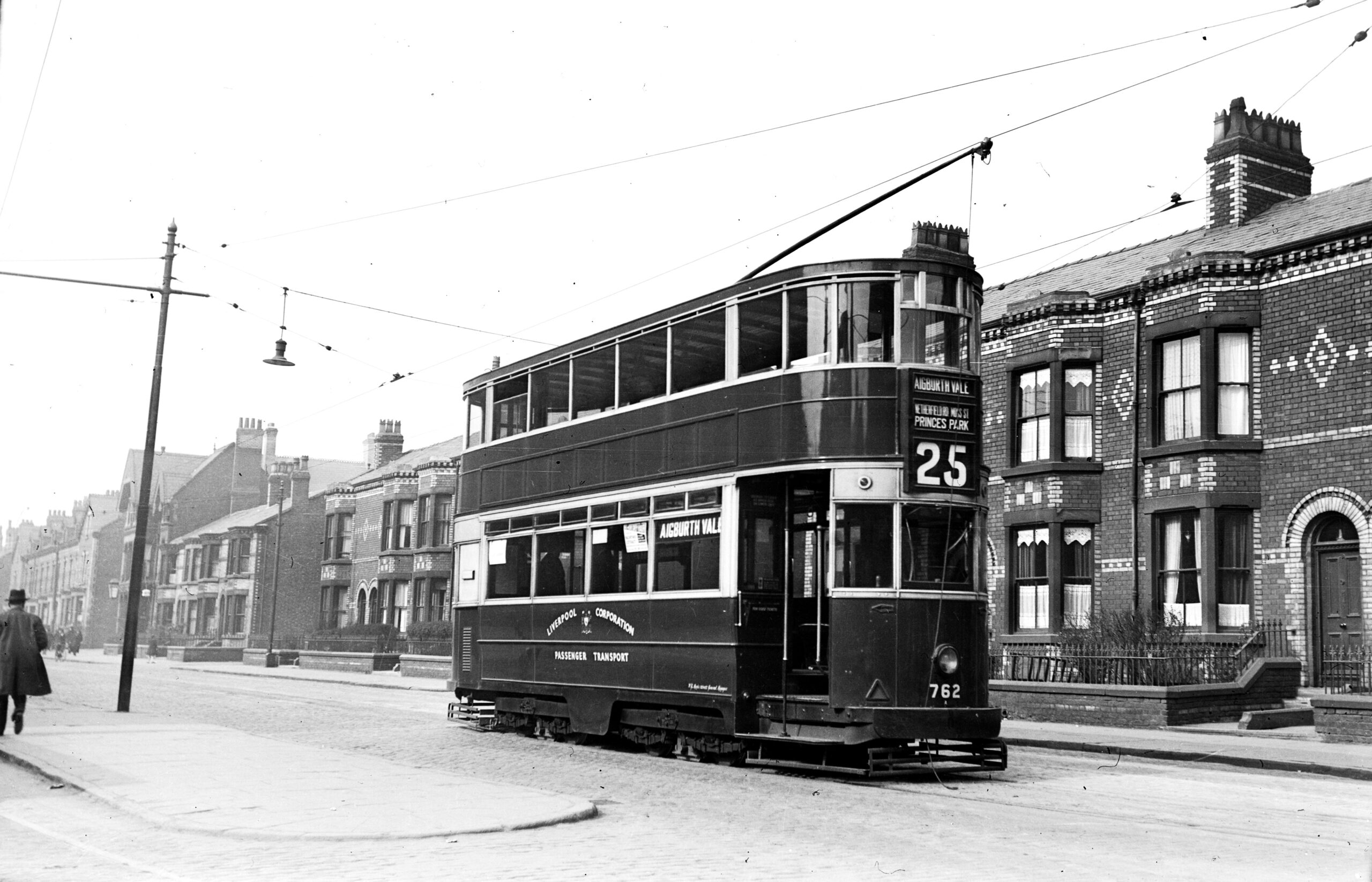
Liverpool 762 photographed by H.B. Priestley on 25th April 1938 sporting its new green livery at the Carisbrooke Road Walton terminus while on the Aigburth Vale – Princes Park route 25. TMS archive.
The English Electric bogie tramcars, as they continued to be known, were also the first of the original, red-liveried tramcars to be repainted in the new green and ivory livery that was first introduced in September 1933. No. 762 received its new livery in 1937. An earlier slight modification was the repositioning of its route number box, which was lowered from above the upper deck front saloon window to just above the driver’s window, which was undertaken between September 1932 and March 1933.
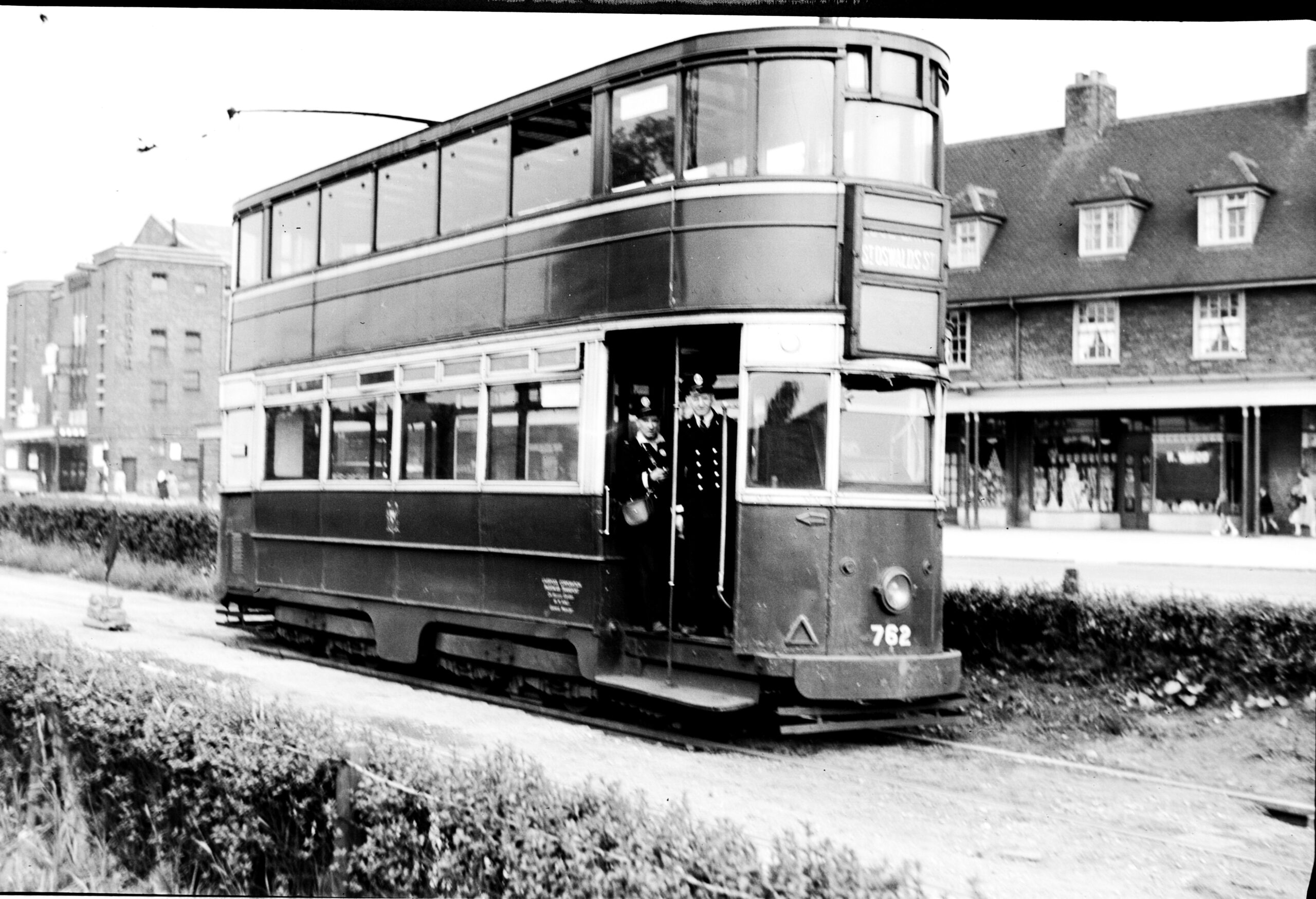
No. 762 photographed by M.J. O’Connor towards the end of its original service life on 8th June 1953, possibly at Page Moss. TMS archive.
Number 762 survived the war in this form and, together with four of its siblings, was regularly called upon for peak hour services during the early 1950s after the disposal of some of the more modern streamliners to Glasgow. All five were withdrawn from service in April and sold on 23rd June 1955, however, to a scrap dealer in Liverpool. The body of 762 alone was spared destruction, having been allocated to the city’s Parks and Garden Department, and spent some time as a bowling green clubhouse in Newsham Park.
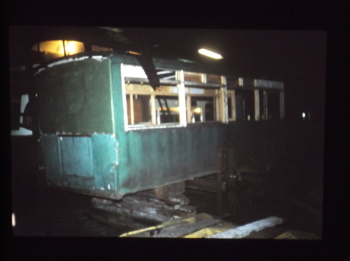
Liverpool 762 lower saloon as found. Photograph courtesy of MTPS
It was then purchased by the Merseyside Tramcar Preservation Society in 1977 and moved to Green Lane Depot. Two years later a lengthy period of painstaking restoration began with the aim of returning the tramcar to its 1930s condition, including the addition of ex-Blackpool inside frame bogies, similar to those with which it was originally equipped. This was interrupted at various times by a shortage of accommodation, resulting in a period of open-air storage, and the competing demands of another restoration project involving Birkenhead 20.
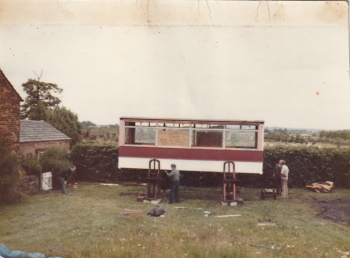
Early restoration work on Liverpool 762. Photograph courtesy of MTPS
By 2001, however, the finished tramcar began operating on the Wirral Heritage Tramway. In September 2010, 762 became the first Liverpool tramcar to run in passenger service at Blackpool, where it was a temporary guest during the Blackpool Trams 125th Anniversary weekend.
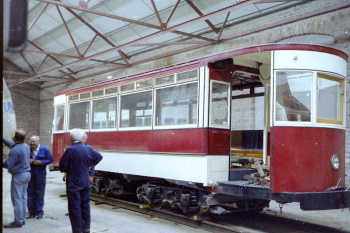
The lower deck of 762 takes shape. Photograph courtesy of MTPS
Unfortunately, the Wirral Heritage Tramway has been adversely affected by successive rounds of cuts that have been inflicted on Wirral Borough Council since it first established the attraction with the aid of European funding in 1995. It was first threatened with closure in 2009, when both Museum and Tramway were initially put up for sale and a proposed sale to Merseytravel eventually fell through after protracted negotiations.
A lifeline was eventually secured by a transfer of operation and management responsibility to volunteers from the Merseyside Tramway Preservation Society, who assumed responsibility for the tramway from January 2014 as part of a proposed asset transfer arrangement. A major refurbishment of the museum was then undertaken in the early part of 2018.
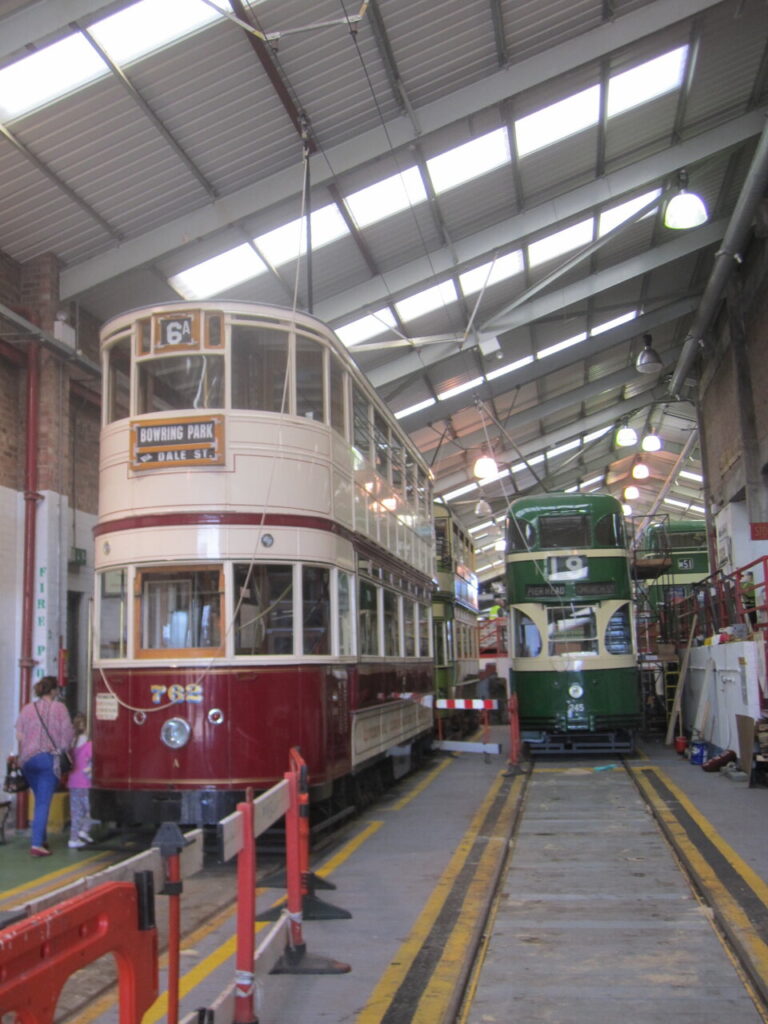
Liverpool 762 sitting alongside Liverpool 245 in the Wirral Heritage Transport Museum on 18th April 2015. Photograph: Jim Dignan
Five years later, a further round of council funding cuts resulted in both tramway and museum being closed once more in April 2023 with custodianship and management of the facility being transferred from the MTPS to Big Heritage, a not-for-profit social enterprise company. This coincided with an inspection carried out by the Office of Road and Rail which resulted in a requirement to complete an extensive programme of work to address various health and safety and related issues, in addition to the major restructuring of the museum itself that Big Heritage is undertaking.
Subsequently, several vehicles have had to be rehomed, either temporarily or permanently, some of which belonged to the MTPS, and the future of another three of its tramcars with strong Merseyside connections, including Liverpool 762, was also thrown into question.
Following extensive deliberations and conversations with interested parties in autumn 2024, the MTPS very generously donated all three trams to the Tramway Museum Society, to join Liverpool streamliner no. 869 – another tramcar that was rescued and preserved by the MPTS with further subsequent restoration being undertaken by the TMS at Crich.
Liverpool 762 helped secure the future of Liverpool’s tramway during the 1930s, thus paving the way for the introduction of its iconic streamliners later in the decade. So, it is perhaps fitting that the two tramcars have been reunited following 762’s arrival at Crich on 23rd March 2025. It will also provide an interesting comparison with near contemporary LCC No. 1, another tramcar that was also designed with a view to rejuvenating an ailing tramway but sadly with a less successful outcome.
Specification
- Type of tram
- Fully enclosed electric double deck bogie tram
- Livery
- Red and cream
- Seating capacity
- 70 (28 downstairs; 42 upstairs)
- Date built
- 1931
- Date entered service
- December 1931
- Manufacturer of body
- Liverpool Corporation Transport
- Manufacturer of truck
- Originally English Electric monomoter equal wheel bogies; EMB Lightweight bogies 1938
- Gauge
- 4ft 8½in
- Motor
- Originally DK131; EE 305 2 x 57hp
- Controller
- Originally electro-pneumatic; EE DB1 Z4
- Current collector
- Trolley Pole
- Modification
Between September 1932 and March 1933: route number box repositioned rom above the upper deck front saloon window to just above the driver’s window.
1937: repainted in green and cream livery.
March 1938: original bogies replaced by EMB lightweight bogies and new more powerful motors fitted while retaining its electric-pneumatic control system.- Withdrawn from service
April 1955
- Subsequent history
Sold for scrap June 1955 but body assigned to parks department for use as a bowling green clubhouse.
- Restoration history
Taken into preservation in 1977 and restored by MTPS to 1930s condition between 1979 and 2001
- Current status
- Restored to operational condition by the MTPS and has seen regular service on the Wirral Heritage Tramway
- Date started operating at Crich
- N/A
- Total mileage covered at Crich
- N/A
- Current location
- Crich depots
- Future plans
Likely to be assessed and overhauled if required, with a view to returning it to operational service if possible.
- 1931 – 1955Operational on original tramway
- 1955 – 1977 Lower saloon converted to bowling green clubhouse
- 1977 – 1979 In storage at Green Lane depot
- 1979 – 2001 Undergoing restoration in a variety of locations
- 2001 – 2023 Operational on the Wirral Heritage Tramway
- 2023 – 2025 In storage at the Wirral Heritage Tramway
- 2025 On display and undergoing assessment at Crich Tramway Museum
